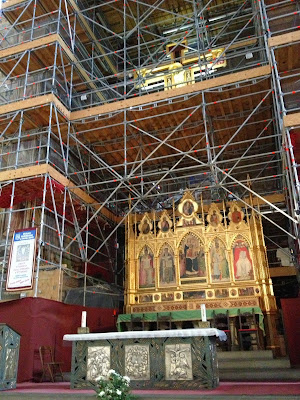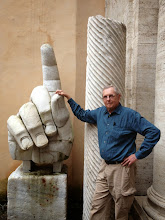Sabbatical leave from Lonestar College, TX, brought a great opportunity –
an eight-week trip to Rome and other Italian cities to study and savor Renaissance
paintings and architecture. I am traveling with Mary Margaret Hansen and the
photos in this post are hers. Our
trip purposefully began in Florence, as this is the city where the Modern World
emerged about 1400.
It was during the early fifteenth century that the people of Florence
discovered the concept of ‘the individual’, which means that a human being
begins to think of himself as unique and looks at his world with fresh eyes,
much as we do today. From that century forward, the ‘old’ view has given way to
the ‘new’ way of experiencing life.
Often as with a birth, there is pain, and inevitably, the ‘new’ triumphs.
Today, we are still living this Renaissance, which began six centuries ago.
In Florence, the ‘new’ took place within the sphere of the arts and as a
part of the ‘body politic’. The citizens of the city, i.e., the rich merchant
class, all male, commissioned artists to depict this fresh world view in
paintings, sculpture and architecture, always using the fragments of the Roman
world as a model. The ‘new’ was at first placed within the traditional
religious iconography, but by the end of the century, older classical
Greco/Roman iconography encroached.
An example of the ‘new’ is the church of Santa Maria Novella.
Here is a night time view of this important church, as seen from our hotel window.
The church was built between the years of 1279-1357 by the Dominican order and was remodeled and given a new facade, designed by Alberti, in the fifteenth century. It is a Renaissance church, filled with the new visual ideas stemming from the rethinking of Classical art.
The walls of Santa Maria Novella contain many frescos depicting the ways that artists saw the world in the fourteenth and fifteenth centuries. For instance, Masaccio's Trinity, dated 1427, is unprecedented for its time. It contains one of the first usages of lineal perspective, classical architectural elements, correct physical anatomy as well as individual portraits of the donors, Mr. and Mrs Lenzi, both buried beneath the fresco.
Here I am looking up at early fourteenth century pre-Renaissance frescos by unknown artists in the Spanish Chapel, adjacent to the church and so named because it was used by Spanish courtiers of Eleonora of Toledo, wife of Cosimo Medici I in the 16th century.
One easily gets a stiff neck by the end of a day. The frescos all begin above the wainscoting and move up and across high ceilings.
And there are always tour groups with all eyes focused upward.
Inside the Santa Maria Novella church itself is another famous fresco by Lippo Lippi, dated in the late fifteenth century which has perspective, classical details, more natural and dramatic human figures, plus a great deal of fantasy.
There are also frescos painted by Ghirlandaio in the church's Tornabuoni Chapel, dated 1485. Ghirlandaio was one of Michaelangelo's first teachers. In this fresco, Tornabuoni family members become participants in the religious scene titled Birth of the Virgin Mary.
Here is another image from the same chapel, which is filled with individual portraits of Florentines. When these frescos appear in art history texts, they look completely different than they do in situ. As you can from this photograph, frescos are stacked one on top of the other in places with little natural light, often making them difficult to see. Sometimes, there are coin operated light sources that shine on the paintings for several minutes.
The streets outside this church are narrow and filled with both pedestrian and vehicular traffic.
A few blocks walk takes us to the Duomo, Santa Maria della Fiore, the largest church of its day. Its construction began in 1296 and took 150 years to complete. Today, it is also 'tourist central'.
The church's present decorative facade was installed in the nineteenth century, five hundred years after the church was originally built.
The shadow comes from the Baptistry, adjacent to the Duomo. It's late in the day and the space is still jammed with tourists.
The Baptistry dates from the fourth century to the thirteenth century.
Brunelleschi is the architect who designed the dome for this church. The dome is an example of revolutionary ideas, this one involving new building technologies. Brunelleschi built this dome with no interior supports. The dome has two interlocking domes, made with bricks. Until the dome of St Peter's in Rome was build one hundred years later, the Duomo was the largest dome in the world. Brunelleschi was the architect and thinker who reinvented the science of perspective.
Here is a view of the Duomo from the top of the Palazzo Vecchio. You can see how it dwarfs other buildings in Florence.
The Arno River runs through the city and is spanned by many bridges. The Ponte Vecchio is a fourteenth century bridge that has been covered with jewelry shops for hundreds of years. Today, it is also a tourist magnet.
Below is a photo of the Palazzo Vecchio, the seat of government in Florence since the fourteenth century. In front of the edifice is the magnificent sculpture of David by Michelangelo. In 1873, the original David was moved to the Academia in an act of preservation. A copy stands in the Plaza Piazza della Signoria.
In front of the Palazzo Vecchio is Neptune Fountain, dated 1575, designed by Ammannati. It is another magnet for tourists with cameras.
Naked statues abound in Italy. And tourists abound too.

Below is Chellini's bronze Perseus with the Head of Medusa 1545
The interior of the Palazzo Vecchio is covered with fresco's from the sixteenth century and generally glorify the Medici family who now controlled and ruled Florence.
Nearby is the Franciscan's Santa Croce, Florence's most important church. Important for several reasons: it is big, many of the city's most important families are buried there and its walls are covered with Renaissance masterpieces.
The church's high altar in under restoration, a problem often found in Italy.
Both Michelangelo and Galileo are buried in Santa Croce as well as many wealthy Florentine families. Below is an image of Michelangelo's tomb. None of his work is included.
Above is as a photo of the Bardi Chapel which has frescos by Giotto, an artist considered the precursor
of the Renaissance.
This fresco is Giotto's Death of St. Francis, painted in the beginning of the fourteenth century. A tomb was placed in front of this fresco in the seventeenth century and Giotto's frescos were white-washed because they were not appreciated and considered old fashioned. They were discovered hundreds of years later when art history became an academic discipline.
Another of Giotto's frescos from the same chapel shows even more damage by the placement of a tomb in front of it. The fresco directly above the greatly damaged one is a favorite of mine. It depicts St. Francis attempts to convert the Sultan of Egypt to Christianity by walking through fire. The Sultan gestures at the saint while his priests exit on the left. It looks so different in a text book. The fresco is magnificent.
The image above is in the Baroncelli Chapel, frescoed by Giotto's pupil Gaddi. After Giotto innovations, every artist worked within his concepts, however, but none displayed the psychological power of his work.
In 1966, Santa Croce was flooded by the Arno and many major works were damaged or destroyed.
Pictured below is what remains of the large Crucifix, painted by Giotto's teacher, Cimabue.
After the flood, restorers spent years salvaging the piece. Much of the damage still remains.
Below is a print of the Santa Croce church. Like the Duomo, it had no facade until the nineteenth century. In 1863, Francis Sloan, an Englishman, paid for the building of the church facade we see today.
Next door to Santa Croce church is the Pazzi Family Chapel, Brunelleschi's last work, completed after his death. The chapel, too, is in all the text books, but truly must be seen to be understood and appreciated.
At last, it's days end and time for a good meal. We venture through the narrow streets to find a small restaurant with simple, tasty food, beginning with a prosciutto and arugula salad and vino de la casa.
Buona Sera











































































